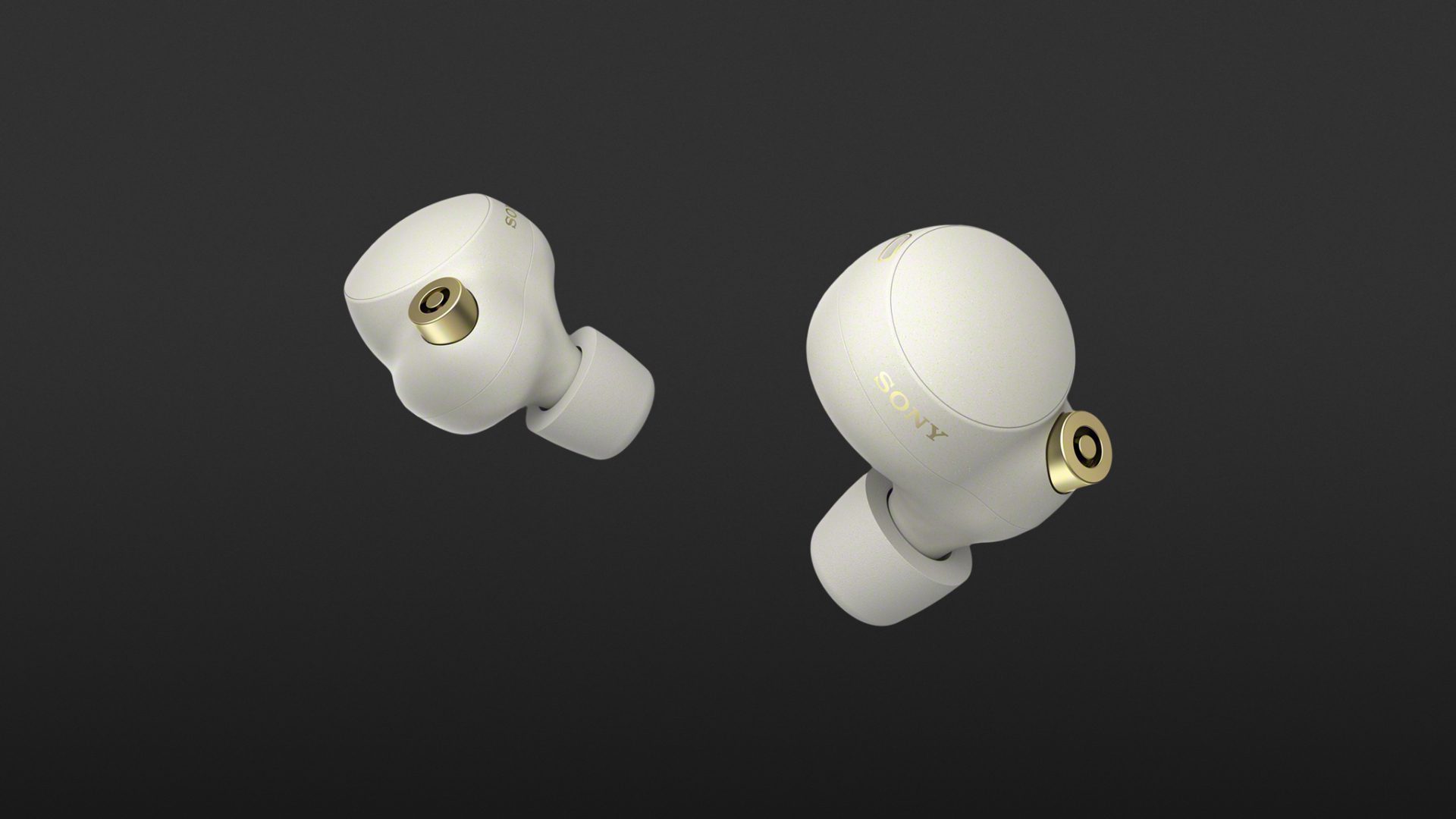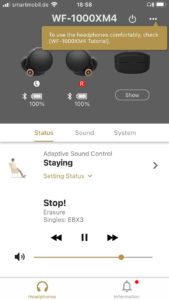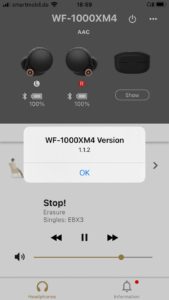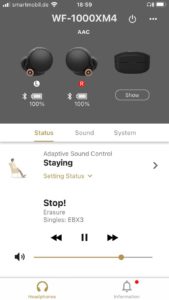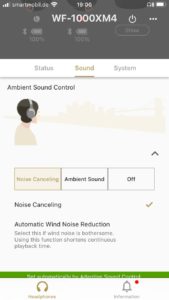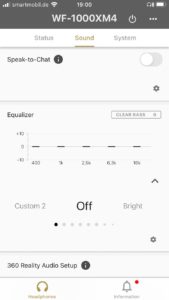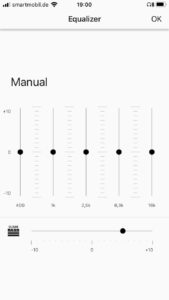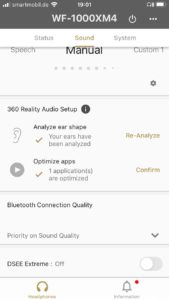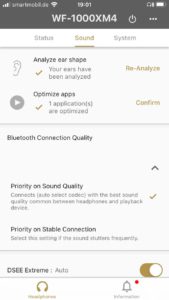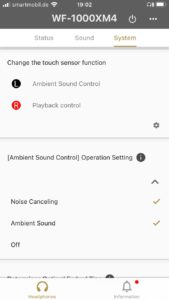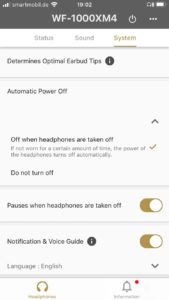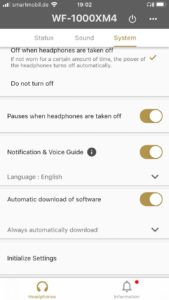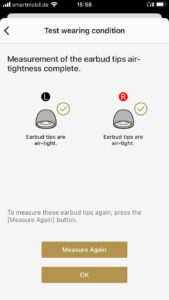With the WF-1000XM4, Sony succeeds in creating a worthy successor to its top-of-the-line True-Wireless model – a real functional giant! In a direct comparison with the WF-1000XM3 from 2019, which is currently on sale for a good price, the new model is ahead in almost every area. It scores points with the best runtime in its class, has improved noise cancelling and better voice quality, offers protection against splashes of water and is HiRes-capable thanks to LDAC support. Finally, the newer driver also plays to its strengths in sound reproduction thanks to increased magnetic capacity.
The price-performance ratio is excellent, and the overall rating for multifunctional all-round use is very good. A few wishes remain unfulfilled, but otherwise, this is already pretty close to measuring up to the complete requirement profile of demanding users for this device category. In terms of price, Sony’s comfort headphones are exactly on a par with Apple’s AirPods Pro, although they are inferior in terms of runtime and do not offer a HiRes codec.
With their previous model WF-1000XM3, Sony already offered one of the most comfortable True Wireless in-ear models. Now in its fourth generation, the popular device has undergone a general overhaul – both internally and externally. Is the upgrade worth it?
The matt, elegant texture of the surface remains. The WF-1000XM4 is once again available in a choice of black or silver-white, with additional stylish upgrades in the form of red gold or gold-coloured logos and design elements. The feather-light, clearly labelled earphones may appear slightly bulky and protrude from the ear, but they fit securely and comfortably for a long time. In contrast to their predecessor, the housings are now protected against water and sweat according to protection class IPX4 and are thus suitable for sports use. The obligatory charging case with its own battery capacity also comes with a new look and is a good deal more compact.
The workmanship of all the hardware is excellent and gives an impression of high quality. This is good because Sony is aiming at a more demanding clientele. The environmentally friendly packaging, which is made entirely of cardboard, is also noteworthy. This may not look particularly stylish, but as we all know, it’s what’s on the inside that counts.
Features
The functionality so extensive that they deserve to be called a really comfortable pair of headphones. Operation is carried out via touch functions as well as by a comprehensive app. The dynamic design works with new 6 mm drivers, which are driven by more powerful neodymium magnets and supported by high-performance electronics and new transducers.
Sony relies on a Bluetooth 5.2 wireless link and, in addition to SBC and AAC codecs, finally also offers the built-in HiRes format LDAC, which supports sampling frequencies of up to 96 kHz and bit rates of up to 990 kbps – provided that an appropriate playback device is available. However, aptX HD is left out, as with their predecessor. Noise cancelling is provided by a dedicated V1 processor. Internal Upsampling technology is also available in an improved form as “DSEE Extreme”.
The battery life is remarkable: depending on the volume and the use of noise-cancelling, it gives eight to twelve hours or five to six hours of talk time. Here, Sony is ahead of its competitors and the previous model. The charging case, with a magnetic lid, is fully charged via USB-C in 1.5 hours, and inductive charging and a fast-charging function are also supported. It provides up to 16 to 24 hours of additional capacity. With these values, the WF-1000XM4 are ideally equipped for daily use, longer trips as well as busy business days. Indicators on the case, in the app and acoustic warnings or multilingual voice prompts indicate a low battery level.
In practice
Initial pairing was quick and easy. Google Fast Pair and Microsoft Swift Pair are now also supported. For later uses, the last partner device is found quickly, straight after opening the charging case. And of course, these earphones can also be used individually. However, the option of pairing the headphones with several transmitters (Multipoint) is still absent, and this would have been desirable, for example, if you want to listen to music from your laptop but don’t want to miss a call on your business phone.
If you appreciate touch control, you will find a full set of features here that goes far beyond the usual offerings of the competition and works perfectly well in practice. First of all, single, double and triple clicks can be used to control music playback, track jumps, voice assistants, noise-cancelling, as well as phone calls and pairing. This works convincingly, although occasional operating errors do occur. Disturbing noise in the ears with “clicks” is kept within limits as the sensors respond smoothly.
The long-proven and regularly updated free “Headphones Connect” app for iOS and Android allows not only firmware updates (status 1.1.5) but also the comprehensive configuration of the functionality, including control of the levels and music playback. The touch functions mentioned can all be configured in groups here. This also allows you to implement the apparently missing volume control, but unfortunately, it doesn’t use the obvious logic of left for quieter, right for louder.
A voice assistant may also be used. This function, which can be switched off, supports Google Assistant and Alexa in addition to your smartphone’s variant.
A special feature of modern Sony headphones are the automatic functions. The WF-1000XM4 is no exception. For example, the ambient sound function, in which ambient sounds are superimposed through the built-in microphones on the headphones for better communication, can not only be switched on and off by touch but also with speech commands (Speak to Chat). The automatic system does not react immediately, but it is quick enough. In the app, it is also possible to adjust the sensitivities as well as the possibility of setting an automatic fallback time for noise-cancelling including automatic start and continuation of music playback. There is also the option of simply holding the touch area on the left earpiece to allow external noise to pass through temporarily. Another practical feature is the automatic pause of playback when the earpiece is removed from the ear (or vice versa, it resumes when replaced).
Furthermore, the noise-cancelling modes (see below) can be determined with movement patterns and switched independently. The same applies to certain locations. This way, noise-cancelling can be activated automatically when walking past a permanent construction site, for example.
The polyurethane fitting adaptors are new, the material feels like a mixture of silicone and memory foam. The fit and the outer insulation is really good, but the choice is limited to three sizes, whereas the predecessor model offered seven variations. In practice, the WF-1000XM4 fit well, securely and comfortably in the ear – even during longer listening sessions. For perfect results, however, I would have liked to see more intermediate sizes. Incidentally, the app is able to verify the fit of these fitting adaptors by checking the air permeability.
In our test, the wireless link enabled practical, interference-free operation with an Apple iPhone 8 and a Sony Xperia 10, with a range over several rooms. With a Sony Smartphone, one can also enjoy the extended bandwidth of LDAC, and the advantages of this are quite evident when using compatible players with the correspondingly high-quality source material.
Noise cancelling
The actual noise cancelling feature in the WF-1000XM4 is comparatively straightforward and can be switched on and off or operated in an alternative mode that suppresses wind noise quite effectively. The best thing about this is the option to switch the operating modes based on action. If “Adaptive Sound Control” is activated, the headphones switch to one of the operating modes “resting position”, “walking”, “running” or “personal traffic” based on these movement patterns or stored locations. The desired settings can be configured for each mode: Noise Cancelling with or without reduction of wind noise, Ambient Sound or neither.
The noise-cancelling function is effective. It works primarily in the low-frequency range and in continuous noise frequencies. Nevertheless: In a train the noise was not completely suppressed. An optimisation function, which takes into account the environment and air pressure, like that provided with the WH-1000XM4 is absent here.
The quiet space this created is nevertheless clearly perceptible, but not so intense as to create a diving bell effect. The improved signal-to-noise ratio is nevertheless excellent when listening to music on the move or in resting positions. The same applies if you want to focus on your work in the office. And, as we mentioned before, there are numerous possibilities for communication so that your colleagues don’t think you’ve become a hermit. A minimal amount of noise is perceptible when noise cancelling is activated, but in practice, it is not a problem. It would have been even better if noise-cancelling could also be regulated in its intensity in each mode. For the ambient sound mode, this is exactly the case, in order to find a good balance between shielding and fed-in outside signals, including a switchable focus on speech.
Sound
The sound of the dynamic drivers is thoroughly convincing. According to the manufacturer, the neodymium magnets offer 20 per cent more power, which should ensure increased precision. Add to this the good external insulation of the fitting pieces and the effective noise cancelling, and a truly quiet space can be created for listening pleasure even in busy environments. Listening pleasure is guaranteed, but it needs a certain level, at least it did for me.
These headphones may not explicitly be aimed at the audiophile specialist market, but, they deliver a first-class performance in the large consumer market for luxury devices. They sound balanced, punchy, detailed and open.
For my liking, the bass seemed a bit lean at first. However, this was more honest than most competitors in this market. In fact, the bass reached down deep with an always exemplary precise contour. Tonalities and dynamic gradations are also clearly recognisable – and that’s exactly how it should be. If you want even more boost, you can use the “Clear Bass” function to help graduate from subtle to strong, without the drivers getting out of step. This also applies to the five other frequencies of the equaliser in the app, which act quite harmoniously.
In the mids, the WF-1000XM4 lay down a detailed and cleanly delineated bed for the essential elements of the mix: voices, central instruments and complex mixes are all credibly reproduced, with these Sony headphones sensibly bridging the gap between warmth and good analytics. Whether with electronic music or tunes with fat guitars, pressure is created (Garbage “Godhead”, Alice in Chains “Check My Brain”). At the same time, the unique character of the mix is also brought out, for example, the basic metallic character of Meshuggah’s Djent classic “Bleed”. Solo instruments and voices are reproduced credibly and with the necessary intimacy when needed. From pop to metal to orchestral works, the WF-1000XM4 always deliver.
In the treble, the WF-1000XM4 provide remarkable detail resolution, thanks to their fast transient response. There is no unwanted harshness, but there are limits to overemphasis. As expected, the unit we tested did not reach the ultimate brilliance of open audiophile designs – here you have to keep in mind the price range, the design as well as the intended ranges of application.
In addition to a broad and precisely animated stereo panorama (Yello “Arthur Spark”), these headphones also provided a good spatial impression, for example in the enveloping version of Whitney Houston’s “Exhale”.
Of course, such aspects are particularly evident with productions in 360 Reality Audio. Here, the panorama is distributed three-dimensionally in a virtual room in your head, so that there is a proper front-back localisation as well as height representation (Dave Brubeck “Take Five”). Although appropriately encoded mixes, available from Tidal and Deezer, can be listened to via any headphones, according to Sony, they are supposed to be even better when there is appropriate processing in the headphones. First, your ears are photographed, and this turned out to be an amusing exercise. Listening with the corresponding profile requires some getting used to. Although you benefit from the extended spatiality, it sounds less powerful and more indirect, at least that was my first impression. The full concert experience did not happen for me.
In conclusion, with the WF-1000XM4 I can put aside my previous scepticism about the built-in sound enhancement DSEE. The current variant, DSEE Extreme, can simply be left in the automatic setting because in terms of improved transparency and more concise spatiality it actually sounds fresher in comparison.
Last but not least, I would also praise the good voice quality, which since the previous model has been improved via directional microphones and bone transmission, as well as for noise suppression (including wind).
Technical specifications
- Ear couplingIn-ear
- Typeclosed
- Transducer principledynamic
- Frequency response (headphones)20 - 40.000 Hz
- Weight without cableca. 41 g
What's in the box
- 3 pairs of ear tips in S, M, L
- USB-C charging cable
- Charging case
Special features
- available in black and silver
- BT codecs: SBC, AAC, LDAC
- BT version: 5.2
- BT profiles: A2DP, AVRCP, HFP, HSP






